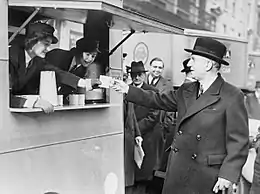Woolton pie
Woolton pie, at first known as Lord Woolton pie,[1] is a pastry dish of vegetables, widely served in Britain in the Second World War when rationing and shortages made other dishes hard to prepare. It was created at the Savoy Hotel in London by its then Maitre Chef de Cuisine, Francis Latry.[2] It was one of a number of recipes commended to the British public by the Ministry of Food during the Second World War to enable a nutritious diet to be maintained despite shortages and rationing of many types of food, especially meat.[3] It was named after Frederick Marquis, 1st Lord Woolton (1883–1964), who popularised the recipe after he became Minister of Food in 1940.
.jpg.webp)
Recipe
The recipe involved dicing and cooking potatoes (or parsnips), cauliflower, carrots and possibly turnip. Other vegetables were added where available. Rolled oats and chopped spring onions were added to the thickened vegetable water which was poured over the vegetables themselves. The dish was topped with potato pastry and grated cheese and served with vegetable gravy. The content of the pie filling could easily be altered to include whatever vegetables were in season at the time.[4]
Reception

People realised that meat was in very scarce supply, but that still did not overcome traditions of meat pies. Woolton pie, entirely lacking meat, was not universally well received. An editorial in The Times commented:[5]
When Woolton pie was being forced on somewhat reluctant tables, Lord Woolton performed a valuable service by submitting to the flashlight camera at public luncheons while eating, with every sign of enjoyment, the dish named after him.
Professor John Fuller has noted that Woolton pie and similar wartime austerity dishes "were forgotten as quickly as possible when conditions returned to normal".[6] (One notable exception to this pattern is carrot cake which, while not invented during the war, was popularised in the United Kingdom during that period because it used the widely available root vegetable in place of some of the scarce flour, fat and sugar found in other cakes.)[7]
Publication
The recipe for Woolton pie has been published on a number of occasions since the war, notably in collections to mark significant anniversaries, e.g. Marguerite Patten's (1985) We'll Eat Again, marking the 40th anniversary of the end of the war in Europe.
See also
References
Citations
- "Lord Woolton Pie: The official recipe", The Times, London, 26 April 1941, p. 2.
- "Woolton pie creator dies", The Times, London, 17 August 1966, p. 1.
- Fussell (1989), p. 202
- Megan Westley (2013). Living on the Home Front. Amberley Publishing Limited. p. 127. ISBN 9781445635415. Retrieved 29 June 2018.
- "An Ounce of Practice", The Times, London, 23 September 1944, p. 5.
- "Vegetables failing to please", The Times, London, 7 January 1970, p. 4.
- Paul Barfoot. "Cracking carrot cake: a brief history and a foolproof recipe for carrot cake victory". BBC Lifestyle. Archived from the original on 18 June 2011. Retrieved 3 February 2017.
Bibliography
- Fussell, Paul (1989), Wartime: Understanding and Behavior in the Second World War, Oxford University Press, ISBN 978-0-19-976331-3
Further reading
- Sitwell, William (2016). Eggs or Anarchy? The Remarkable Story of the Man Tasked with the Impossible: To Feed a Nation at War. London: Simon & Schuster. ISBN 978-1-4711-5105-7.
External links
- Woolton Pie (includes original recipe from The Times)